FR / EN
visitor's itinerary
The birth of a masterpiece:
the Three Musketeers
or the “Miracle Child of Alexandre Dumas”.
On Thursday, March 14, 1844, the readers of Le Siècle discovered on the front page of their Parisian magazine the first chapter of a new novel signed by Alexandre Dumas. It is only with reluctance that the French writer, who considered himself a dramatist, contemplated writing serial novels, a literary genre which required that each new instalment had a certain number of pages or line requirements while each subsequent issue of the serialized magazine meant an additional suspenseful styled section of the story. While working on his historical study Louis XIV and His Century, Dumas familiarized himself with the annals of the Grand Siècle by reading the memoirs of La Rochefoucault and the works of Lomélie de Brienne which inspired him with the sequence on the Queen’s diamond pendants or “ferrets” as they were called at the time. The apocryphal memoir-novel of French novelist Courtilz de Sandras entitled Mémoires de Monsieur d'Artagnan was to serve as a model for the portrayal of d'Artagnan, his friends Athos, Porthos and Aramis and the she-villain Milady de Winter. The production of The Three Musketeers marked the apogee of the literary collaboration between Alexandre Dumas and Auguste Maquet, a man of great learning. While Maquet outlined the plot, the characters and the dialogues in draft form, Dumas rewrote each chapter prior to publication.
-
Caricature depicting Dumas dressed as a musketeer
1/5 In November 1853, following the financial collapse of his Théâtre Historique, Dumas started a new journal called Le Mousquetaire. What started as a great success failed in 1857. This caricature playfully suggests the relaunching of this journal in November 1866, which definitively closed on April 25, 1867. 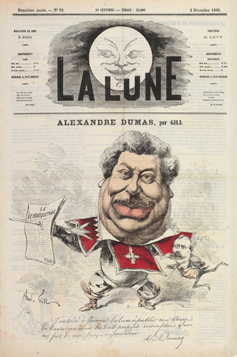
LouisAlexandre Gosset de Guines, a.k.a. André Gill (18401885).
Caricature of Dumas dressed as a musketeer. Published in La Lune, No. 39, December 2, 1866.
Private Collection. -
The Musketeer’s tabard
2/5 The successful operacomique Le pré aux clercs (The Clerks' Meadow) was composed in 1832 by Hérold. Based on Prosper Mérimée’s Chronique du temps de Charles IX, the action takes place during the French Wars of Religion. Since the Musketeers of the Guards were created in 1622, the presence of tabards during the brilliant 1891 representation of this operacomique in the Salle Favart must merely be seen as an anachronism. Nowadays, beyond the popularity of the novel itself, the international fame of the heroes created by Alexandre Dumas is maintained by the movie industry. It was Dumas himself who started this mutation on October 27, 1847with his first sensational performance of The Three Musketeers given at the theatre of the AmbiguComique, from an adaptation of the recently serialized Twenty Years Later. 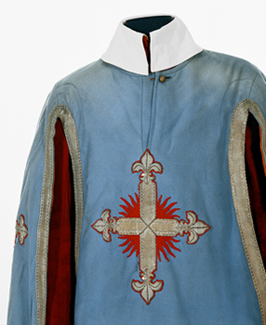
Designed for the operacomique Le pré aux clercs (The Clerks' Meadow),
music by Ferdinand Herold, and libretto by Eugène de Planard.
Salle Favart Wardrobe, 1891.
Opéra national de Paris / Centre national du Costume de Scène – Moulins -
Autograph leaflet of the The Vicomte of Bragelonne: Ten Years Later
3/5 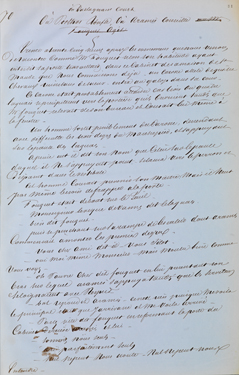
Alexandre Dumas (18021870). Ink on paper, before 1847.
Paris, Bibliothèque nationale de France, Département des Manuscrits. Inv.: NAF 14993 -
Autograph manuscript of the final draft of Les Trois Mousquetaires
4/5 Alexandre Dumas and Auguste Maquet had set up a specific strategic editorial concept which they playfully referred to as the “Botte de Plans”, with Maquet in charge of providing the plot, the characters and the dialogues in draft forms and Dumas rewriting and giving the final touches to each chapter. 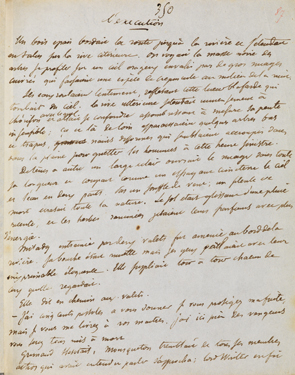
Auguste Maquet (18131888).
Ink on paper, before 1844.
Paris, Bibliothèque nationale de France, Département des Manuscrits.
Inv.: NAF 11944 -
Portrait of Alexandre Dumas
by Nadar, 18555/5 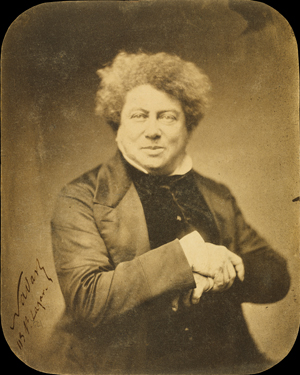
Nadar (Pseudonym of French photograph GaspardFélix Tournachon, 18201910).
Paris, Bibliothèque nationale de France, Département des Estampes et de la Photographie.
Inv.: EO15 (2)PET FOL




